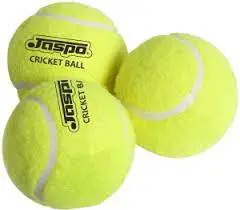When it comes to playing tennis, the weight of the tennis ball is an important factor that can impact your game. Tennis balls come in a variety of weights, and choosing the right weight can affect how the ball bounces, how much control you have over the ball, and even how fatigued your arm becomes during a match.
The International Tennis Federation (ITF) regulations specify that a tennis ball must have a diameter between 2.575 and 2.7 inches (approximately 6.54 to 6.86 centimeters) and a weight between 2 and 2.1 ounces.
It’s important you know that tennis balls may vary slightly in weight due to factors such as the brand, specific model, and wear and tear from use. However, the weight range mentioned above represents the standard weight for most tennis balls used in competitive play and recreational tennis.
What is the weight of a standard tennis ball?

A standard tennis ball has a weight of approximately 58 grams or 2.07 ounces. This weight is regulated by the International Tennis Federation (ITF) and is used in professional and amateur tennis matches worldwide.
The weight of a tennis ball is important because it affects the ball’s bounce and flight through the air. A heavier ball will bounce less and move more slowly through the air, while a lighter ball will bounce higher and move faster through the air.
Tennis balls are made of a rubber core that is covered in a felt-like material. The core is pressurized, which also affects the ball’s bounce and flight. The ITF also regulates the pressure of a standard tennis ball, which is 12 psi or pounds per square inch.
It is worth noting that there can be slight variations in weight among different brands and types of tennis balls. For example, some tennis balls may be slightly lighter or heavier than the standard weight due to differences in materials or manufacturing processes. However, these differences are usually negligible and will not significantly affect the ball’s performance on the court.
Overall, the weight of a standard tennis ball is an important factor to consider when playing tennis. By using balls that meet the ITF regulations for weight and pressure, players can ensure a consistent and fair playing experience.
How is the weight of a tennis ball determined?
The weight of a tennis ball is determined by the materials used in its construction and the manufacturing process.
Tennis balls are made of a rubber core that is covered in a felt-like material. The rubber core is molded into a sphere shape, and the felt covering is then added by the machine. The felt covering is made of wool or synthetic fibers, which are wrapped tightly around the rubber core and glued in place.
Once the felt covering is in place, the tennis ball is weighed to ensure that it meets the International Tennis Federation’s (ITF) regulations for weight. The ITF requires that a standard tennis ball weigh between 56 and 59.4 grams, with a target weight of 58 grams. This weight is important for ensuring that the ball bounces and moves consistently during play.
In addition to weight, the ITF also regulates the pressure of a standard tennis ball, which is 12 psi or pounds per square inch. This pressure is maintained by the rubber core, which is pressurized during the manufacturing process.
Overall, the weight of a tennis ball is determined by the materials used in its construction, the manufacturing process, and adherence to ITF regulations. By ensuring that tennis balls meet these standards, players can have a consistent and fair playing experience on the court.
Why is the weight of a tennis ball important?

The weight of a tennis ball is an important factor in the game of tennis because it affects the ball’s performance on the court.
Here are some of the reasons why weight is important:
- Bounce: The weight of a tennis ball affects how high it bounces. A heavier ball will bounce less and lower, while a lighter ball will bounce higher. The height of the bounce can impact the player’s ability to hit the ball accurately and with the desired power.
- Flight: The weight of a tennis ball also affects how it moves through the air. A heavier ball will move more slowly through the air, while a lighter ball will move faster. This can affect the trajectory of the ball and how much spin the player is able to put on it.
- Arm Fatigue: The weight of a tennis ball can also impact the player’s arm fatigue. A heavier ball requires more effort to hit, which can cause the player’s arm to tire more quickly. This can impact their ability to play at a high level for extended periods of time.
- Consistency: Finally, the weight of a tennis ball is important for consistency. Players need to be able to rely on the ball’s weight and bounce being consistent from one shot to the next. This allows them to develop a consistent playing style and strategy.
How does the weight of a tennis ball affect its performance?
The weight of a tennis ball can have a significant impact on its performance. In general, a heavier tennis ball will travel faster and hit harder, but it may also be more difficult to control.
A standard tennis ball weighs between 56 and 59.4 grams, but some tennis balls are designed to be lighter or heavier than this range. Lighter tennis balls may be used for younger players or for training purposes, as they are easier to handle and control. However, they may not provide the same level of power and speed as a standard ball.
On the other hand, heavier tennis balls may be used by more advanced players who are looking for greater power and speed in their shots. They can also help to simulate the feel of a match ball in training. However, they may be more difficult to control and can cause more strain on the player’s arm and shoulder.
In addition to weight, other factors such as the ball’s size, surface, and compression can also affect its performance. It’s important for players to choose a tennis ball that is appropriate for their level of play and the type of court surface they will be playing on, in order to optimize their performance and minimize the risk of injury.
What is the difference between a heavy and a light tennis ball?
The main difference between a heavy and a light tennis ball is its weight. A heavy tennis ball weighs more than a light tennis ball.
Heavy tennis balls are typically used by advanced players who want to generate more power and speed in their shots. They are also commonly used in training to help players develop their strength and technique. Because of their weight, heavy tennis balls require more effort to hit, but they can also be more difficult to control.
On the other hand, light tennis balls are typically used by younger players or beginners who are still developing their skills. They are also commonly used in training to help players work on their coordination and control. Because of their lighter weight, they are easier to hit and control, but they may not provide the same level of power and speed as a heavy ball.
It’s worth noting that there are also different types of tennis balls designed for different playing surfaces, such as clay or grass courts. These balls may have different weights, sizes, and levels of compression depending on the surface they are intended for. Players should choose the appropriate type of ball for their level of play and the surface they will be playing on in order to optimize their performance.
How to choose the right tennis ball weight for your game?

Choosing the right tennis ball weight is an important factor to consider when it comes to playing tennis. The weight of a tennis ball can affect how the ball behaves during play, including its bounce, speed, and spin.
Here are some tips on how to choose the right tennis ball weight for your game:
- Consider your skill level: If you are a beginner, it is recommended to start with a lighter ball. A lighter ball will move slower and give you more time to react, making it easier to learn the basics of the game. As you improve, you can move on to heavier balls for more challenging play.
- Consider the court surface: Different court surfaces can affect how the ball behaves. For example, clay courts tend to slow the ball down, so a heavier ball may be needed to compensate. On the other hand, hard courts tend to speed the ball up, so a lighter ball may be more appropriate.
- Consider your playing style: If you are an aggressive player who likes to hit hard, a heavier ball may be more suitable. This is because a heavier ball will carry more momentum and be harder to return. If you prefer a finesse game with more spin, a lighter ball may be better as it will be easier to control.
- Experiment with different ball weights: Ultimately, the best way to determine the right ball weight for your game is to experiment with different options. Try playing with different weights and see which one feels the most comfortable and allows you to play your best.
In general, tennis balls come in three different weights: light, regular, and heavy. Light balls weigh around 2.5 ounces, regular balls weigh around 2.7 ounces, and heavy balls weigh around 2.9 ounces. Keep in mind that different brands may have slightly different weights, so it’s always a good idea to check the packaging before purchasing.
Different types of tennis balls and their weight ranges
There are different types of tennis balls available on the market, each with its unique features and specifications.
Here are some of the most common types of tennis balls and their weight ranges:
- Regular-duty tennis balls: Regular-duty tennis balls are the most commonly used balls for playing on clay or indoor courts. They weigh around 2.7 ounces and are designed to provide good control and durability.
- Extra-duty tennis balls: Extra-duty tennis balls are heavier and more durable than regular-duty balls. They are designed for playing on hard courts and outdoor surfaces, which can cause more wear and tear on the ball. Extra-duty balls weigh around 2.9 ounces.
- High-altitude tennis balls: High-altitude tennis balls are specifically designed for use at higher elevations where the air is thinner, making the ball move faster. These balls are similar in weight to regular duty balls, but they have a lower air pressure to compensate for the thinner air.
- Kids’ tennis balls: Kids’ tennis balls are smaller and lighter than regular tennis balls, making them easier for young players to handle. They weigh around 2.1 ounces and are designed to be slower and lower bouncing than regular balls.
- Practice tennis balls: Practice tennis balls are usually cheaper and less durable than regular game balls. They are designed for use during training sessions and practice matches, rather than for serious gameplay. Practice balls may come in different weight ranges, but they are generally similar in weight to regular-duty balls.
It’s important to note that the weight ranges for tennis balls may vary slightly depending on the manufacturer. When selecting a tennis ball, be sure to check the packaging for the weight range and other specifications. Choosing the right type of tennis ball can help improve your game and ensure that you are playing with the appropriate equipment for your skill level and playing surface.
How to measure the weight of a tennis ball accurately?
Measuring the weight of a tennis ball accurately is important for ensuring that you are using the appropriate ball for your game.
Here are some steps to follow to measure the weight of a tennis ball accurately:
- Use a scale: The most accurate way to measure the weight of a tennis ball is to use a scale. You can use a kitchen scale or a specialized scale designed for measuring sports equipment.
- Place the ball on the scale: Place the tennis ball on the scale, making sure that it is sitting flat and not rolling around. If the ball is not sitting flat, gently press down on it to stabilize it.
- Read the weight: Once the ball is stable on the scale, read the weight measurement. Most tennis balls will weigh between 2.5 and 2.9 ounces, depending on the type and manufacturer.
- Check for accuracy: To ensure that the scale is accurate, you can check it against a known weight, such as a small weight or coin.
- Repeat for multiple balls: If you are measuring the weight of several tennis balls, repeat the process for each ball to ensure that they are all within the appropriate weight range.
It’s important to note that the weight of a tennis ball can also be affected by factors such as air pressure and humidity. For the most accurate measurement, try to measure the weight of a tennis ball under consistent conditions, such as in a temperature-controlled room with stable humidity levels.
The impact of temperature and altitude on tennis ball weight
Temperature and altitude can both have an impact on the weight of a tennis ball. Here’s how:
- Temperature: Temperature can affect the pressure of the air inside a tennis ball, which in turn can affect the weight of the ball. When the temperature increases, the air inside the ball expands, causing the ball to become slightly lighter. Conversely, when the temperature decreases, the air inside the ball contracts, causing the ball to become slightly heavier.
- Altitude: Altitude can also affect the weight of a tennis ball. At higher elevations, the air is thinner and less dense, which can cause the ball to feel lighter and travel faster. This is because there is less air resistance to slow the ball down. In contrast, at lower elevations, the air is denser, which can make the ball feel heavier and travel slower.
To compensate for the effects of altitude, some tennis balls are specifically designed for use at high elevations. These balls have a lower internal pressure, which helps to offset the effects of the thinner air. However, it’s important to note that even with high-altitude balls, players may still need to adjust their technique to account for the faster ball speed.
How to maintain the weight of tennis balls?
To maintain the weight of tennis balls, it’s important to store them properly and avoid exposing them to extreme temperatures or moisture.
Here are some tips to help you maintain the weight of your tennis balls:
- Store them in a cool, dry place: Tennis balls are made of rubber and can be affected by temperature changes. Store them in a cool and dry place, away from direct sunlight or moisture. Avoid storing them in hot areas like a car trunk or a garage during the summer months.
- Use a container with a tight lid: Keep your tennis balls in a container with a tight-fitting lid to protect them from moisture and dust. This will help them maintain their weight and bounce for longer.
- Rotate the balls regularly: If you have several cans of tennis balls, rotate them regularly to ensure that they all get equal use. This will help them wear out at the same rate and maintain their weight and bounce.
- Avoid leaving them in the pressurized cans: If you open a new can of tennis balls, remove the plastic wrap and transfer them to a container with a tight-fitting lid. Leaving them in the pressurized can for too long can cause them to lose their bounce and weight.
By following these tips, you can help maintain the weight of your tennis balls and ensure that they last for as long as possible.
The effect of weight on tennis ball bounce and speed
The weight of a tennis ball can have an impact on its bounce and speed.
Bounce:
A heavier tennis ball will generally bounce higher than a lighter ball. This is because a heavier ball will have more mass and therefore more energy to transfer to the ground when it hits the surface.
The rebounding force of the ground will then propel the ball upwards, resulting in a higher bounce. However, the difference in bounce height between different weights of tennis balls is generally small and may not be noticeable to the average player.
Speed:
A lighter tennis ball will generally travel faster than a heavier ball when hit with the same force. This is because a lighter ball has less mass and therefore less inertia. When hit with the same force, a lighter ball will accelerate faster and travel faster than a heavier ball. However, the difference in speed between different weights of tennis balls is generally small and may not be noticeable to the average player.
It’s important to note that the International Tennis Federation (ITF) has strict regulations on the weight and size of tennis balls used in official matches. The standard weight of a tennis ball is between 56 and 59.4 grams. Any variation outside of this range can affect the ball’s performance and is not allowed in official matches.
How to train with different tennis ball weights for better performance?

Training with different tennis ball weights can help improve your performance by developing different aspects of your game.
Here are some tips on how to train with different tennis ball weights:
- Lighter balls for speed and reaction time: Using lighter tennis balls, such as foam or low-compression balls, can help improve your speed and reaction time. These balls are easier to hit and travel faster than regular tennis balls, which can help you develop faster reflexes and improve your footwork.
- Heavier balls for strength and power: Training with heavier tennis balls, such as weighted balls, can help improve your strength and power. These balls require more force to hit and can help build muscle in your arms, shoulders, and upper body. This can translate into more power and speed on your regular tennis strokes.
- Regular balls for technique and consistency: Regular tennis balls are the standard for training and playing tennis. Practicing with regular balls can help improve your technique, consistency, and overall performance. Using regular balls can help you develop a feel for the weight and bounce of the ball, which is crucial for playing tennis at a competitive level.
It’s important to note that you should always warm up before using any type of tennis ball, especially if you’re using heavier balls. Start with lighter balls and gradually increase the weight as you get more comfortable. Also, make sure to use the correct technique and form when hitting the different balls to avoid injury and get the most out of your training.
Recommended:
- How much is quartz worth?
- How long is 2 inches?
- How long is 9 inches?
- How big is 1 acre?
- How big is a 27 inch monitor?
Conclusion
If you need to know about tennis ball weight, we have got you covered here. The weight of a tennis ball can have an impact on its bounce and speed. A heavier ball will generally bounce higher than a lighter ball, while a lighter ball will travel faster than a heavier ball when hit with the same force.
Training with different tennis ball weights can help improve different aspects of your game, such as speed, power, and technique. However, it’s important to use the correct technique and form when hitting the different balls to avoid injury and get the most out of your training. Additionally, the International Tennis Federation (ITF) has strict regulations on the weight and size of tennis balls used in official matches.


